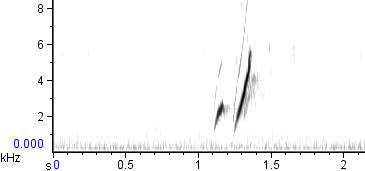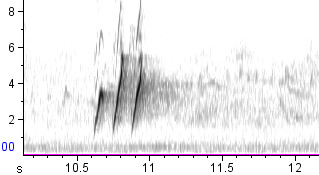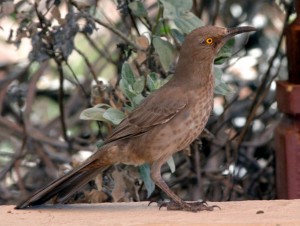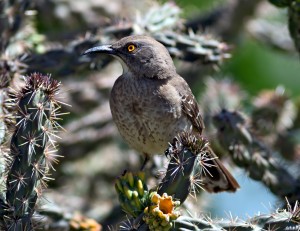Curve-billed Thrasher Identification
The AOU checklist committee recently rejected a proposal to split the Curve-billed Thrasher into two species: the “Palmer’s” Thrasher (palmeri group) in Arizona and West Mexico, and the nominate or “Eastern” Curve-billed Thrasher (curvirostre group) in the rest of the bird’s range.
Although very similar, the two groups can usually be distinguished by sight. In the photos above, note that the eastern bird (right) has a much whiter background color to the breast, resulting in stronger contrast with the breast spots; it also shows sharper and bolder white highlights in the wings and tail. The stronger throat pattern, with a more distinct dark line bordering the white throat, may also be significant. However, the much colder, grayer tone to the plumage overall is likely an artifact of photo lighting.
Interestingly, one of the committee members who voted “yes” on the split did so in large part because of differences in the call notes between the two forms, which I hadn’t seen discussed anywhere before:
YES. I now favor splitting palmeri – the clincher for me is that palmeri has distinct call note differences, a clear upslurred whit-wheet, as opposed to a two note whit-whit in which both notes are the same.
I have investigated this difference, and it seems to hold up across (at least) most of the species’ US range. The vast majority of the call recordings I could find from well inside the range of “Palmer’s” Thrasher showed the same typical pattern: two upslurred whistles that started at the same pitch, with the second one ending much higher:

Whereas the call of eastern curvirostre-group Curve-billed Thrashers consist of nearly identical notes, both upslurred across a wide frequency range like the second note of the “Palmer’s” call:

Both groups of Curve-billed Thrashers give versions of this call with 3 or more notes, particularly when they are excited. When the eastern curvirostre group does so, as you can see in the spectrogram above, all the notes tend to be similar. When western palmeri birds extend their calls, the first note is usually of the stunted variety. The third note (and any subsequent notes) tend to be like the second, but a little softer, so that the second note ends up getting the emphasis: “wit-WEET-weet”:

Some Curve-billed Thrashers in southeast Arizona give multi-note calls that are difficult to classify. Here’s a bird from a few miles south of Eloy in Pinal County, where I believe the palmeri subspecies would be expected:

Here’s some more from the same individual bird:
The two-note versions of this individual’s call tend to seem like the reverse of the typical palmeri pattern, with the second note quieter and less extensively upslurred than the others. One might suppose this could be an intermediate bird, since the palmeri and curvirostre groups apparently overlap in southeast Arizona, but most educated guesses that I’ve seen have placed the overlap zone farther east, between Tucson and the New Mexico border. I don’t believe this bird was identified visually to subspecies, so it remains a question mark for now.
Just to whet the appetite of the curious, here’s a Curve-billed Thrasher call from the Oaxaca valley in southern Mexico, which preliminary DNA studies showed as being distinct from either the palmeri or the curvirostre group (though apparently more closely allied with the latter). Note again the “WEET-wit” pattern, which is the reverse of palmeri’s:
Obviously, more sampling is needed to fill in the many gaps in our knowledge of the Curve-billed Thrasher and its vocal variation. Amateur recordists of the southwestern US and Mexico, this is your cue.


3 thoughts on “Curve-billed Thrasher Identification”
Hi Nathan, I just saw this post, and coincidentally I had published a page about identifying these subspecies just a couple of weeks earlier at http://www.sibleyguides.com/bird-info/curve-billed-thrasher/. I’m happy to be able to update the comments on calls there, and I agree that this is a great opportunity for birders in that region to discover some new stuff about a common bird!
There is a lot of interesting info available on Edward Palmer, as in “palmeri”. See the young readers’ book, PLANTS IN HIS PACK, by Janice J. Beaty (Pantheon, 1964). On p. 78 she refers to “Toxostoma curvirostre palmeri, the curve-billed or Palmer’s thrasher”.
See also EDWARD PALMER: PLANT EXPLORER OF THE AMERICAN WEST, by Rogers McVaugh (U of Oklahoma Press, 1956), and my own (edited) EDWARD PALMER’S ARKANSAW MOUNDS (U. of Arkansas Press, 1990; reprinted by U of Alabama Press, 2010).
— Marvin D. Jeter, Arkansas Archeological Survey
Hi Nathan,
Thanks for bringing this to our attention. Those of us who hang out in that area should be documenting the range of those things, so I checked through my recordings and found a couple of samples. Just south of Grants in w. New Mexico (but east of the continental divide) I recorded (on the fourth visit) a couple of two-note calls that sound like your sample from Carlsbad, and also the very first call on Andrew’s XC cut. Spectrographically, the second note is parallel to the first, and a little lower in amplitude.
I have a recording from San Simon, just a dozen miles into Arizona from New Mexico, that is classic palmeri.
Obviously, lots more data are needed to map these two forms.
–Arch
Comments are closed.